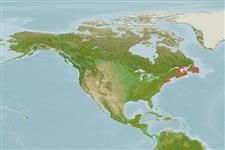Common names from other countries
Environment: milieu / climate zone / depth range / distribution range
Ecologia
marinhas; Água doce; estuarina bentopelágico; intervalo de profundidade 0 - 3 m (Ref. 85409). Temperate; 4°C - 20°C (Ref. 2059); 51°N - 35°N
Western Atlantic: Gulf of St. Lawrence in Canada to North Carolina, USA. Mainly a near-shore marine species, but far inland populations occur in lakes in Nova Scotia in Canada and in Hudson, Delaware and Susquehanna River drainages (Ref. 5723).
Tamanho / Peso / Idade
Maturity: Lm ? range ? - ? cm
Max length : 6.4 cm TL macho/indeterminado; (Ref. 5723); common length : 4.1 cm TL macho/indeterminado; (Ref. 12193); Idade máx. registada: 3.00 anos (Ref. 12193)
Adults occur mainly along weedy bays and backwaters, entering brackish water and to a limited extent, fresh water (Ref. 3814). Feed along the bottom, primarily on diatoms, worms and crustaceans by sucking in the prey with a pipetting action (Ref. 27549). Males build, guard and aerate the nest where the eggs are deposited (Ref. 205).
Life cycle and mating behavior
Maturidade | Reprodução | Desova | Ovos | Fecundidade | Larvas
The male builds, guards and aerates the nest (Ref. 205).
Robins, C.R., R.M. Bailey, C.E. Bond, J.R. Brooker, E.A. Lachner, R.N. Lea and W.B. Scott, 1991. Common and scientific names of fishes from the United States and Canada. Am. Fish. Soc. Spec. Publ. (20):183 p. (Ref. 3814)
Categoria na Lista Vermelha da IUCN (Ref. 130435)
CITES (Ref. 128078)
Not Evaluated
Ameaça para o homem
Harmless
Utilização humana
Aquário: Aquários públicos
Mais informação
ReferênciasAquaculturaPerfil para aquaculturaEstirpesGenéticaElectrophoresesHereditariedadeDoençasProcessamentoMass conversion
ColaboradoresFotografiasStamps, Coins Misc.SonsCiguateraVelocidadeTipo de nataçãoÁrea branquialOutras referênciasCérebrosVisão
Ferramentas
Relatórios especiais
Descarregue XML
Fontes da internet
Estimates based on models
Preferred temperature (Ref.
115969): 4.2 - 12.7, mean 6.4 (based on 228 cells).
Phylogenetic diversity index (Ref.
82804): PD
50 = 1.0000 [Uniqueness, from 0.5 = low to 2.0 = high].
Bayesian length-weight: a=0.01047 (0.00408 - 0.02689), b=3.07 (2.85 - 3.29), in cm Total Length, based on LWR estimates for this (Sub)family-body shape (Ref.
93245).
Nível Trófico (Ref.
69278): 3.2 ±0.38 se; based on food items.
Resiliência (Ref.
120179): Elevada, tempo mínimo de duplicação da população menor que 15 meses (K=0.84; tmax=3).
Fishing Vulnerability (Ref.
59153): Low vulnerability (16 of 100).
